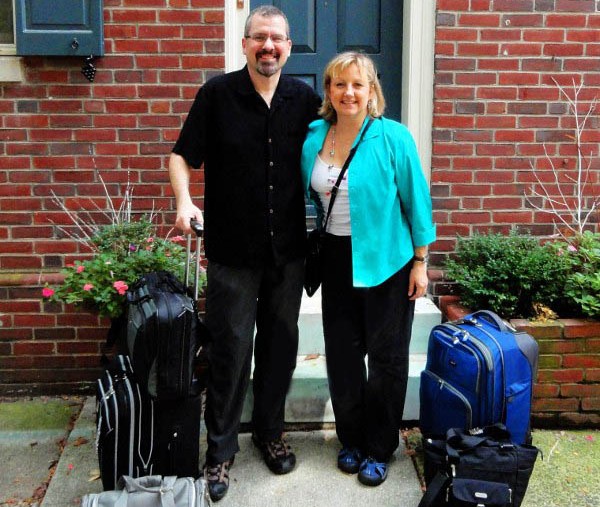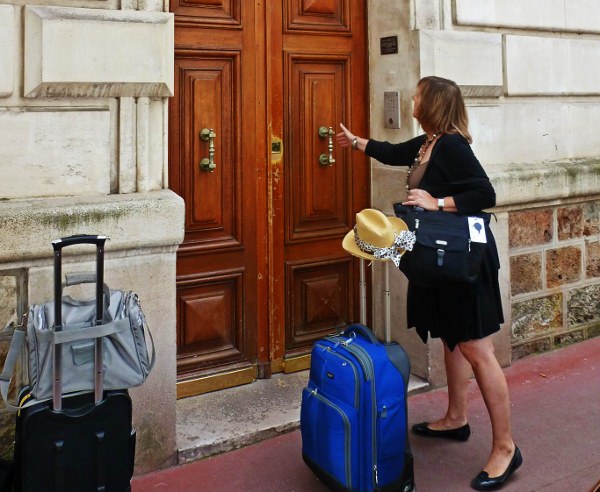Career Breaks: They’re Not Just for Backpackers

When we first started telling people about planning our round-the-world trip, we often got the comment: “You two are going to backpack?”
The short (and literal) answer was “no.” We’re in our fifties, so this didn’t seem like a good time to start teaching our old spines new tricks. Yet this is often the image of a round-the-world journey: people with overloaded backpacks trudging through airports and train stations. But there are alternatives.
Consider Your Itinerary: Indoor or Outdoor?
Think about the types of places you’ll visit during your career break. Where will you be hauling your luggage? Through built-up areas or through the woods? Unless you’re planning to spend a lot of time in the great outdoors, it’s probably easier to take a wheeled suitcase. Our itinerary includes visits to major cities, with a few road trips in between. We won’t be camping, so backpacking is not an issue for us.
We each took one 22” wheeled suitcase along with a tote bag, plus one small carry-on bag to share. Each of our smaller bags has a sleeve to slide it onto the handle of the wheelie. Whenever we have long walks we are actually carrying very little, just pulling our belongings beside us. Most airports, train stations and buildings have ramps and elevators, so we’ve rarely had to carry our bags.
Expand Your Lodging Horizons: Beyond Hotels and Hostels
Anyone traveling long-term needs to alter their concept of lodging. What works on a one or two-week vacation is not going to cut it for months on the road. Hotels and hostels each have their advantages, but when staying for more than a week, they feel cramped, and hotels in particular can get expensive. We crave privacy and space to stretch out. A place to call “home,” even if it’s just for a week or so.
We chronicled our journey for The Philadelphia Inquirer as well as our own blog, so we spend many hours writing. Wherever we stay is also our workplace, so it’s nice to have more space to write.
The best option for us has been vacation rentals.

Short-term rentals are well equipped and cost-effective. In major cities they’re often cheaper for two people than staying in a hostel. As a rule, $30-$50 per person per night will get you a one bedroom flat with a fully equipped kitchen, wi-fi and sometimes even a washer and dryer. Having our own kitchen means we save money on meals, especially since we can stock up on a few staples to use over the week. Since we both love to cook, it’s fun to visit the local food markets and buy fresh ingredients. Imagine visiting the spice market in Istanbul and going back to your flat to whip up some couscous. Or picking up fresh shrimp and cilantro in Saigon to make a rice vermicelli dish . . . delicious!
There are many sites that offer properties with photos, pricing and online booking. Some have global reach, such as Airbnb and Homeaway; others are more regional, such as Stayz in Australia and Holiday Lettings in the UK and Europe. For longer-term rentals (usually a month or more) we’ve been happy with Sabbatical Homes. Regardless of where you’re going, simply start with a search using the terms “vacation rentals,” “holiday rentals” or “self-catering” and your destination. Plenty of options will come up, and you can create your own list of favorite sites.
Most of these sites are listing services. You contact the property’s owner through the site and discuss any booking questions such as dates, facilities, etc. with them directly. Pricing structures vary by site and country. Airbnb, for example, quotes prices on a per night basis plus a 10% service charge for booking. In the United States, it’s common for owners to add a one-time cleaning charge to the cost of the rental. In Europe these fees are usually included, but VAT might be extra. Be sure to calculate your total cost so you can make an informed decision.

Since you are dealing directly with the owner, it is possible to negotiate pricing. Often they will quote prices on a nightly basis, then offer discounts for weekly or monthly stays. Off-season rates will be cheaper, and booking last-minute might get you a discount if an owner doesn’t want their property to go empty.
The best aspect of renting a flat (or cottage or cabin) is that we can immerse ourselves in our surroundings. Rentals are typically located in “real” neighborhoods, not in the “tourist ghettos” full of hotels and souvenir shops. We love buying our food in the local markets and getting to know some of the nearby residents, who are often our landlords. In the bush country of Australia, our host took us in his pickup truck for an impromptu kangaroo-viewing safari on his 3,000-acre ranch; we played ball with the neighborhood kids in Bali, and the owner of our flat in Malta gave us a homemade figolla, the traditional Maltese Easter cake. These are experiences we probably wouldn’t have had in a hotel or hostel.
When we started out on our career break, we wanted to feel like we were living in, not just passing through, our various destinations. We’ve rented places in Asia, Oceania, the Middle East, and Europe, have had great experiences everywhere, and met some fantastic people. And it’s convenient to simply wheel a suitcase through the door.
Larissa & Michael Milne turned 50, sold everything and embarked on a 1+ year round-the-world trip in August 2011. They have been writing about their experiences for The Philadelphia Inquirer and have been chronicling their journey on their own site, Changes in Longitude. They also participated in the national Meet, Plan, Go! event in New York City on October 16, 2012.






